Nature-Inspired Decoupage: Using Foliage and Botanicals in Your Art
The diverse shapes, colors, and textures of the natural world provide endless inspiration for decoupage designs. Leaves, flowers, feathers, butterflies, seeds, woodgrain, and other organic motifs add beauty and dimension when incorporated creatively into decoupage art. Whether using printed nature papers or actual preserved organic materials, natural decoupage elevates functional crafts and home décor with organic energy. Follow these tips for selecting, preparing, cutting, and decoratively employing leaves, petals, herbs, and other botanical inclusions within stunning nature-based decoupage art.
Gathering Natural Materials for Decoupage
Keep an eye out for these decoupage possibilities while enjoying the outdoors:
Leaves
Collect interesting pressed leaves, ferns, or leaf skeletons to decoupage. Skeletal leaves offer delicate lace-like textures.
Flowers and Petals
Dry hardy flower heads, roses, hydrangeas, pansies, daisies, and salvage leftover event petals to decoupage.
Herbs and Plants
Gather small bundles of fresh herbs like rosemary or lavender to dry and include on decoupage designs. Their aroma enhances pieces.
Seeds and Pods
Integrate tiny seeds, pinecones, acorns, pods, nuts, dried mushrooms, and interesting seed heads.
Insects and Butterflies
Press or frame actual delicate butterflies, beetles, or cicadas using decoupage to preserve their beauty.
Feathers
source ethically gathered feathers to decoupage in creatively layered clusters and arrangements.
Wood Textures
Cut interesting wood cross-sections or bark rubbings to decoupage for natural woodgrain effects.
Prepping Organic Materials for Decoupage
Proper drying and preservation lets natural elements be incorporated durably.
Pressing Flowers and Leaves
Preserve color vibrancy by drying inclusions between absorbent sheets weighted under heavy books or in flower presses.
Dehydrating Herbs
Hang small herb bundles to air dry fully to retain aromatic oils within leaves.
Treating Delicate Materials
Use hairspray or specialty sprays to stiffen and protect fragile dried flower petals or butterfly wings.
Laminating with Adhesives
Coat leaves and fragile materials with sealants like decoupage glue or resin to reinforce.
Trimming Stems
Trim dried flower stems and thick veins from leaves to flatten inclusions and prevent bulk under decoupage.
Checking for Pests
Ensure no bugs or eggs are hidden in organic materials before decoupaging. Freeze or heat to kill any pests.
Cutting Natural Materials Creatively
Strategic cutting of organic materials makes decoupaged designs more cohesive.
Matching Printed Papers
Cut leaves, flowers, or feathers to coordinate with printed glossy decoupage papers featuring similar botanicals.
Repeating Organic Patterns
Cut multiples of the same leaf, petal, or seed shapes from gathered materials to create synchronized organic arrangements on decoupage art.
Strategic Layering
Cut inclusion layers in progressing sizes and orientations to naturally build up depth and dimension.
Following Contours
Cut leaf veins, flower petals, bark edges, and other organic inclusions to fit and accentuate the contours of 3D decoupage surfaces.
Combining Multiple Materials
Let different natural elements play off each other through thoughtful clustering, overlapping, and placement.
Leaving Natural Edge Texture
Avoid over-trimming botanical materials so their inherent organic edges add textural interest.
Arranging Organic Materials Decoratively
Thoughtful placement creates naturally inspired decoupage art.
Composing Realistically
Mimic how foliage and flowers grow in nature, with graceful spreading stems and scattered groupings.
Creating Repetition and Rhythm
Repeat motifs like a flower or specific leaf shape rhythmically across the surface to tie pieces together.
Radial Effects
Show movement by arranging leaves pointing outward from a central flower or seed head.
Contrasting Colors and Textures
Allow glossy leaves and matte petals to play against each other for added depth.
Asymmetric Balance
Offset decoupage layers with organic shapes clustered more heavily towards edges rather than centering all inclusions.
Enhancing Dimensionality
Use real preserved dimensional leaves, petals, and bark rubbings to add physical depth and shadow.
Sealing and Protecting Natural Decoupage
Special steps integrate and shield natural materials used in decoupage.
Choosing Sealants
Select flexible decoupage mediums so natural materials can expand and contract without cracking.
Pressing While Drying
Weight pressed natural materials while decoupage sealants dry to prevent curling edges.
Building up Thin Layers
Apply multiple thin layers of sealant when including dimensional materials to avoid bulkiness.
Brushwork Direction
Brush sealants in the direction of leaf veins or flower petals to smooth them down rather than lifting edges.
Edge Binding
Use specialty tapes, stitching, or extra sealant around material edges to prevent delamination over time.
UV Protection
Shield decoupage with botanical inclusions from sunlight to prevent fading. UV coatings also help.
Ideas for Nature-Inspired Decoupage Projects
Let nature motifs elevate these creative decoupage ideas:
Botanical Books
Decoupage real pressed flowers onto book cover edges to capture a moment in the pages’ natural history.
Pet Memorials
Honor passed pets by decoupaging their actual pawprints or custom portraits into shadowboxes.
Seasonal Wreaths
Accent seasonal wreaths with decoupaged leaves, herbs, seed pods, nuts, and dried fruits coordinated to each time of year.
Tuscan-Inspired Bowls
Adorn serving bowls with grapes, vines, olive branches, and terra cotta textures invoking Italian wine country.
Butterfly Boxes
Preserve iridescent butterfly wings in glass-topped jewelry boxes decoupaged with flower imagery.
Herbarium Specimen Framing
Frame and identify pressed botanical specimens like a traditional herbarium using decoupage techniques.
Allow the elegance of nature to inspire your decoupage designs. Preserve ephemeral beauty through the seasons by incorporating organic materials creatively.
